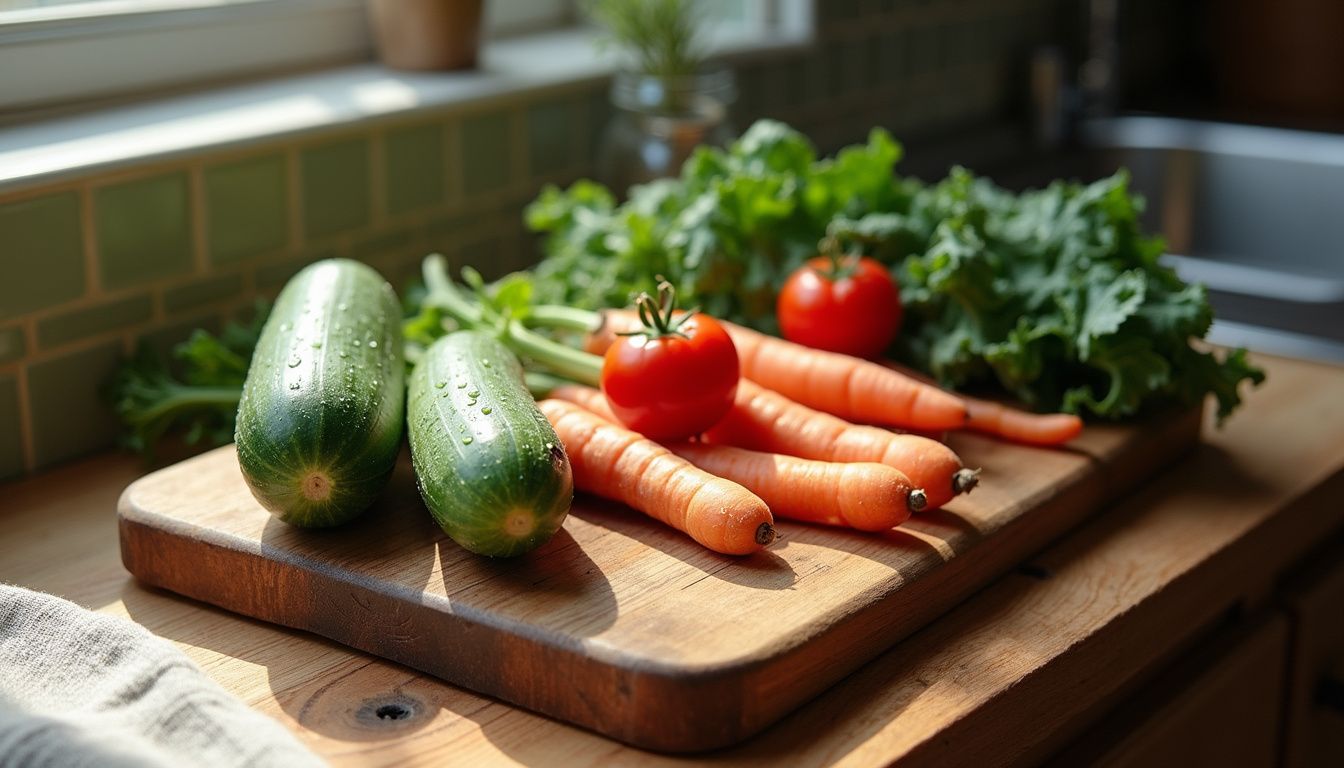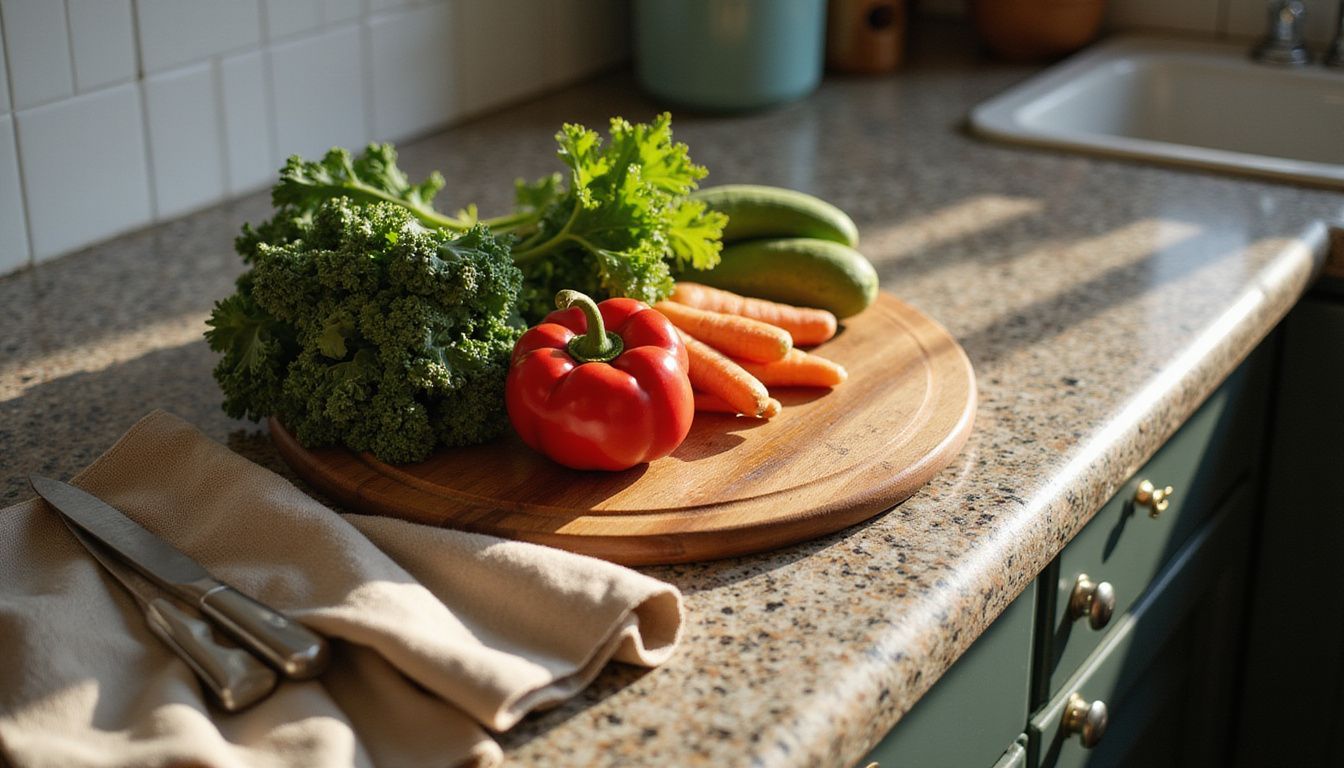Top 7 Low Calorie Vegetables For Weight Loss
Our Nutrition Assistant AI Suite will transform your body. You will lose fat, get toned, and build muscle. Gain confidence and optimal health.
Many people try to lose weight and end up feeling hungry. That can make healthy habits hard to keep. After reviewing the evidence, I found that eating low calorie vegetables helps me feel full while still meeting my weight goals.
These vegetables are packed with vitamins, minerals, and fiber, yet they are low in calories per serving. In this article, I share my top picks so you can add volume to your meals without adding many extra calories or fat.
You can start today. Add a few of these simple options to your daily routine and notice how much better you feel.
Key Takeaways
- Spinach, zucchini, celery, cauliflower, bell peppers, cucumber, and asparagus are low-calorie choices that provide fiber and essential vitamins to support weight loss.
- One cup of raw spinach has about 7 calories and supplies over half the daily value for vitamin A and nearly double for vitamin K.
- High-fiber vegetables slow digestion and reduce hunger. Research shows higher fiber intake improves appetite control during weight management.
- Foods high in water and fiber, such as zucchini or cucumber, help you feel full with fewer calories per meal.
- Replacing calorie-dense foods with low-calorie vegetables is linked with greater long-term weight loss success.

Benefits of Low-Calorie Vegetables for Weight Loss Success

Low-calorie vegetables let me enjoy bigger portions for fewer calories. These nutrient-dense foods keep me full and satisfied, which makes weight control easier to maintain.
How Does High Fiber Content Help Weight Loss?
High fiber foods fill me up using fewer calories. Dietary fiber is the part of plants the body cannot fully digest. It moves slowly through the gut, which steadies hunger and supports appetite control.
Studies find that people who eat more fiber feel satisfied longer and snack less on high-calorie items. Fiber also helps blunt sharp blood sugar spikes after meals. That reduces cravings and helps me stay on track.
What Essential Nutrients Do These Vegetables Provide?
Leafy greens and cruciferous vegetables are low in calories and rich in vitamins and minerals. Spinach offers vitamin K, folate, iron, and magnesium with very few calories.
Zucchini supplies vitamin C, potassium, and plenty of water for hydration. Celery is a good source of vitamin K and is mostly water, which adds volume for almost no calories.
Cauliflower adds vitamin C, folate, fiber, and protective plant compounds without raising calorie or fat content. Bell peppers give beta-carotene, which the body converts to vitamin A, along with fiber and vitamin C.
A cup of chopped bell pepper can provide over 100 percent of your daily value for vitamin C. Cucumbers are rich in water and supply small amounts of potassium and fiber.
Asparagus contributes vitamins A and K, folate, and manganese while staying low in fat and calories.
Vibrant vegetables like spinach or bell pepper help me eat more nutrients while keeping calories low.
Why Is Low Energy Density Important for Weight Loss?
Low energy density means fewer calories per gram of food. That lets me eat a larger amount of food, such as fruits and vegetables, while still taking in fewer calories.
Meals that are high in water and fiber help me feel full with fewer calories. Vegetables fit this pattern well because water and fiber increase volume without added fat or sugar.
Research in the American Journal of Clinical Nutrition links higher intake of low-calorie foods with more weight loss than diets that rely on calorie-dense options. Choosing vegetables instead of high-calorie snacks supports a healthy weight over time.
Top 7 Low-Calorie Vegetables Perfect for Weight Loss
I choose low calorie foods to support a healthy diet and steady weight management. These vegetables are low in calories but full of nutrients that help me feel satisfied while trying to lose weight.
What Nutrients Make Spinach a Superfood?
Spinach is packed with vitamin K for bone health and normal blood clotting. It also provides fiber and some protein while staying very low in fat and calories.
One cup of raw spinach delivers over half the daily value for vitamin A and nearly double for vitamin K. These antioxidants support overall health during weight loss.
Harvard sources note that spinach supplies iron, magnesium, calcium, folate, and potassium that support heart health. Its high water content adds bulk without many calories.
I add fresh spinach to salads or sandwiches because it helps me feel full with minimal calories.
One cup of raw spinach has only about 7 calories yet delivers iron, folate, and vitamins A and K.
How Does Zucchini Support Weight Loss?
Zucchini is a low-calorie vegetable that adds bulk to meals. One cup of sliced zucchini has about 20 calories and provides fiber and water that help manage hunger.
I add zucchini to soups or sauté it with a little olive oil for filling dishes that stay light. The high water content makes each serving feel larger and more satisfying.
Since zucchini has low energy density, I stay full longer while keeping calorie intake under control. It is a simple way to support healthy eating patterns.
Why Is Celery a Great Hydrating Snack?
Celery is about 95 percent water, so it helps with hydration. It is a refreshing snack after exercise or on hot days. I slice celery and pair it with peanut butter for a crunchy, satisfying bite that stays low in calories.
Celery is an excellent source of vitamin K and also supplies fiber. High-water vegetables can support weight loss because they fill me up without many calories.
The next vegetable, cauliflower, offers even more ways to stay full on fewer calories.
What Are the Health Benefits of Cauliflower?
Cauliflower is a cruciferous vegetable that supports weight loss. One cup has about 25 calories and a good amount of fiber, which helps control hunger.
It supplies vitamin C, vitamin B6, folate, potassium, and other minerals important for a healthy diet. Evidence from reviews and large studies in the United States links higher intake of fruits and vegetables with lower risk of type 2 diabetes and cardiovascular disease.
I sauté cauliflower with olive oil or use it as a rice substitute to lower calories without losing texture or flavor. Cruciferous vegetables provide antioxidants that support overall health during weight loss.
Its low fat content and mild taste make cauliflower easy to use in many meals that follow the Dietary Guidelines for Americans.
How Do Bell Peppers Aid Weight Loss?
Bell peppers are low in calories and high in water. A cup of chopped bell peppers has about 39 calories and adds bright flavor without much fat.
They provide fiber to help control hunger. Bell peppers also supply vitamin C and a range of carotenoids, including beta-carotene and capsanthin, which support heart and immune health.
I add peppers to salads or sauté them with a small amount of cooking oil for a crisp, low-calorie side. Slices with hummus make an easy snack that replaces higher-calorie choices.
Why Is Cucumber a Refreshing Low-Calorie Option?
Cucumber is a hydrating, low-calorie food. It is about 95 percent water and has roughly 16 calories per cup. That helps fight hunger while keeping calorie intake low.
As a source of vitamin C and potassium, cucumber adds hydration and useful nutrients. I slice cucumbers into salads or add them with mint to make infused water in warm months.
The crunch refreshes me after workouts. Research shows that high-water foods help reduce total daily calories because they add volume without many calories.
Next, I will cover how asparagus can support digestion and overall health.
…
[1] Rolls BJ, et al. Energy density and its role in obesity treatment. American Journal of Clinical Nutrition, 1999.
How Does Asparagus Improve Digestion and Health?
Asparagus contains both soluble and insoluble fiber. Soluble fiber forms a gel in the gut that slows digestion. Insoluble fiber adds bulk, which helps prevent constipation.
Asparagus also acts as a prebiotic, meaning it feeds the good bacteria in the gut. It provides potassium, iron, and folate, which support normal cell function.
I noticed more regular digestion after adding asparagus to salads with kale or lettuce a few times a week. My hunger between meals dropped because high-fiber foods help me stay full longer.
Research shows asparagus is low in calories yet rich in key nutrients. It is a smart choice for anyone focused on diet and weight goals.
What Are the Nutritional Profiles of These Vegetables?
Each vegetable offers a mix of vitamins, minerals, and fiber that support weight loss. Knowing the basics helps me choose the right options for daily meals.
What Are the Key Benefits of Spinach?
Spinach delivers powerful nutrition with very few calories. One cup of raw spinach has about 7 calories, more than half the daily value for vitamin A, and almost double for vitamin K.
It is high in fiber, which supports digestion and helps curb hunger. I mix spinach with other low calorie vegetables like watercress or cabbage to make meals filling without many calories.
Spinach also supplies iron, magnesium, and potassium for muscle and heart health. Lutein, an antioxidant, supports eye health.
What Nutrients Does Zucchini Offer?
Zucchini stands out for weight management. It has about 17 calories per 100 grams, so it helps control hunger without adding many calories.
Each serving offers potassium and manganese, plus vitamin C for immune support. Zucchini contains fiber and water, which aid digestion and hydration.
I use zucchini ribbons as a base for salads or as a wrap filling. It adds a lot of volume to meals while staying low in fat and sugar.
What Makes Celery Nutrient-Rich?
Celery has a high water content and helps with hydration. Each stalk provides vitamins K and C and minerals such as potassium and folate.
One cup of raw celery has about 16 calories and includes fiber that supports digestion. Dietitians often recommend it in salads or as a crunchy snack.
I add chopped celery to soups or pair it with nut butter to boost flavor without many calories.
What Vitamins and Minerals Are in Cauliflower?
Cauliflower contains vitamins C and K along with several B vitamins. One cup of raw cauliflower provides about 77 percent of the daily value for vitamin C. Vitamin K supports normal blood clotting.
Folate supports cell growth and development. Cauliflower also provides potassium for healthy blood pressure and magnesium for muscles.
Its fiber supports digestion and helps control hunger when I aim to eat fewer calories.
How Does Bell Pepper Support Nutrition?
Bell peppers are notable for vitamin C. One medium orange bell pepper contains about 152 milligrams of vitamin C, which is more than twice that of a medium orange.
They also provide vitamin A, potassium, and small amounts of iron and magnesium. Antioxidants in peppers may help reduce inflammation and support healthy skin.
Their fiber helps keep hunger under control without many calories. I often add chopped bell pepper to salads with tomato, carrot, radish, or apple for extra color and crunch.
What Are the Health Attributes of Cucumber?
Cucumber is a low-calorie, high-water snack. A cup of sliced cucumber has only 16 calories and provides potassium and magnesium.
The skin is a source of fiber, which supports digestion and fullness. I add cucumber slices to salads or enjoy them as a cool snack in summer.
Vitamin C in cucumber supports healthy skin. Seeds add small amounts of protein and other beneficial plant compounds.
Eating fruits and vegetables helps control weight because these lower calorie foods can reduce energy intake while boosting nutrition.
What Essential Nutrients Does Asparagus Provide?
Asparagus provides many essential nutrients with few calories. One cup of cooked asparagus has about 40 calories, which makes it a smart everyday option.
It offers fiber for fullness and steady digestion. It also contains potassium, iron, phosphorus, calcium, and magnesium.
Vitamins include A, C, E, K, and B vitamins such as folate. Asparagus has more protein than many vegetables, close to 4 grams per cup cooked.
Its antioxidants help protect cells from damage. I like asparagus with potatoes or tossed into salads with olive oil and a handful of almonds for healthy fats.
How to Add Low-Calorie Vegetables to Your Daily Diet
I add low-calorie vegetables to most meals for better nutrition and steady energy. Here are simple ways to use them every day.
How Can You Use Vegetables in Salads and Wraps?
I chop spinach, cucumber, and bell peppers for crisp salads with bright flavor. Sliced zucchini or shredded carrots make wraps more filling while staying low in calories.
Diced turnip adds extra crunch and minerals like potassium. Celery sticks layered with lean protein and a few nuts work as a quick wrap alternative.
Thinly sliced cauliflower adds bulk without many calories and pairs well with strawberries for a sweet twist. Each serving delivers nutrients that support weight loss without losing taste or variety.
What Are the Best Ways to Add Vegetables to Soups and Stews?
I add spinach or chopped zucchini early so their flavor blends into the broth. Bell peppers, celery, and cauliflower soften well when diced small, keeping texture and color.
For stews, I toss in asparagus near the end to keep it tender-crisp. I blend cooked cauliflower into broth for a creamy texture with far fewer calories than cream.
Cucumbers work best in cold soups like gazpacho since heat makes them soft. Thinly sliced strawberries can brighten chilled vegetable stews during summer.
For more nutrition, I sprinkle sliced almonds right before serving. They add crunch along with fiber and minerals.
How Can Grilling or Roasting Vegetables Help?
Grilling or roasting brings out natural sweetness without added sugar. The dry heat concentrates flavor and keeps calorie counts low.
Peppers become sweeter in the oven while staying light. Grilled zucchini and roasted cauliflower develop a crisp edge that feels satisfying.
Roasted asparagus has under 30 calories per serving and is rich in fiber. These methods need little oil, so they keep meals tasty and calorie smart.
What Are Some Healthy Vegetable Snack Ideas?
On busy days, I like snacks that need no cooking. Sliced cucumbers with a pinch of sea salt make a fresh, crisp treat.
Baby carrots and celery sticks pair well with hummus for extra protein and flavor. Cauliflower florets with lemon juice add a zesty crunch, and bell pepper strips bring color and key nutrients.
Cherry tomatoes with cottage cheese give calcium and energy without many calories. Mini pepper halves with light cream cheese or celery with nut butter add healthy fats and fiber.
Spinach with sliced strawberries creates a sweet and savory bowl rich in vitamins C and K. These snacks keep me full between meals and support my goals.
What Extra Tips Boost Weight Loss with Vegetables?
Small meal strategies make vegetables work even harder for weight loss. A few smart choices help me get the most from these nutrient-rich foods each day.
Why Combine Vegetables with Lean Proteins?
Pairing low-calorie vegetables with lean proteins like chicken breast, tofu, or eggs increases fullness after meals. Protein slows digestion, so I stay satisfied longer.
Studies show higher protein meals can raise metabolism slightly and help preserve muscle during weight loss. Vegetables add vitamins and minerals at a low calorie cost, while protein provides amino acids for repair and immune support.
For example, I fill a whole grain wrap with lean turkey, spinach, and crunchy celery for energy and balance without many calories.
How to Choose Low-Calorie Vegetable Preparations?
I use steaming and roasting because they add minimal calories from fat. Grilling zucchini or asparagus keeps flavor high and calorie counts low.
I check labels on canned foods or spreads to avoid added sugars and excess oil. Light dressings, fresh herbs, and spices boost taste without heavy sauces.
Simple cooking helps keep spinach, celery, and cucumber healthy and preserves key nutrients that support weight loss.
Should You Eat Fresh or Steamed Vegetables for Weight Loss?
Fresh vegetables like cucumber or spinach offer crunch and higher water content, which can improve fullness. Steaming protects many vitamins such as vitamin C and folate, and it softens fiber for easier digestion.
Both fresh and steamed vegetables keep most of their nutrients while staying low in calories. Steaming broccoli or asparagus can even make some antioxidants easier to absorb.
Adding raw strawberry slices to a salad provides natural sweetness without extra sugar. Either method supports weight loss if I keep portions reasonable and skip heavy butter or creamy dressings.
Common Questions About Low-Calorie Vegetables
People often ask how to fit low-calorie vegetables into daily life. These quick answers can guide your plan.
Are Low-Calorie Vegetables Suitable for Different Diets?
Low-calorie vegetables fit into keto, vegan, Mediterranean, DASH, and paleo styles. Spinach and zucchini add fiber without many carbs or sugars. Cauliflower works as a rice or pizza base, since one cup has about 25 calories and roughly 5 grams of carbohydrates.
Vegetarians use bell peppers or asparagus to get vitamins A, C, K, folate, and potassium with few calories. Low energy density means larger portions for fewer calories, which supports many weight plans.
Guidance from public health sources in the United States supports eating plenty of non-starchy vegetables for long-term health.
Is There a Limit to How Many Vegetables You Should Eat?
Most experts agree that a wide variety of vegetables supports weight loss and overall health. There is no strict upper limit for most people.
Some people feel bloated if they add too much fiber too fast. I noticed that when I jumped from two to five cups a day, then felt fine after a few days as my body adjusted.
People with kidney issues or those on certain medicines should talk with a clinician before making big changes to fiber or potassium intake. Drinking more water helps when increasing fiber.
When Is the Best Time to Eat Low-Calorie Vegetables?
Eating vegetables at the start of a meal helps me feel full sooner and lowers total calories. Fiber-rich foods like spinach or bell peppers slow digestion and can help manage blood sugar levels throughout the day.
Low-calorie vegetables also make great snacks between meals. I often pick celery sticks or cucumber slices in the afternoon to curb hunger and keep energy steady.
Eating these options regularly at lunch and dinner makes it easier to stay on a balanced plan without feeling deprived.
Conclusion
Choosing low calorie vegetables supports weight loss while keeping meals satisfying. Spinach, zucchini, celery, cauliflower, bell peppers, cucumber, and asparagus provide fiber and essential nutrients with few calories. Each one adds flavor, texture, and staying power to daily meals.
I use them every day in salads, soups, wraps, and snacks. Evidence shows that high-fiber foods improve appetite control, which can lead to better results over time. If you have a medical condition or take prescription medicines, seek personal advice from a licensed health professional before making big diet changes.
…
[1] Slavin JL. Dietary fiber and body weight. Nutrition, 2005; 21(3):411-418.
FAQs
1. Which vegetables are included in the top 7 low calorie options for weight loss?
The most effective choices include cucumbers, leafy greens such as spinach, cruciferous plants like broccoli and cauliflower, bell peppers, zucchini, celery stalks, and radishes. These foods contain few calories per serving yet offer high fiber content.
2. How do these vegetables support weight loss according to research?
Studies show that eating more of these plant-based foods increases satiety due to their water and fiber content while keeping total energy intake low (Rolls et al., 2004). This helps reduce overall calorie consumption without causing hunger.
3. What nutritional benefits do these vegetables provide besides being low in calories?
These options supply essential vitamins such as vitamin C from bell peppers or folate from leafy greens; they also deliver minerals like potassium found in celery stalks and antioxidants present in cruciferous varieties. Such nutrients help maintain health during a reduced-calorie diet (USDA FoodData Central).
4. Can you share a practical way to add more of these vegetables into daily meals?
In my experience preparing salads with mixed leafy greens or adding sliced cucumbers and radishes boosts meal volume without extra calories. Roasting broccoli florets or sautéing zucchini slices makes side dishes flavorful yet light on energy intake.
Summary: The seven highlighted plant-based foods are rich in nutrients but low in calories; scientific evidence supports their role in promoting fullness and aiding weight management when incorporated regularly into balanced diets.







